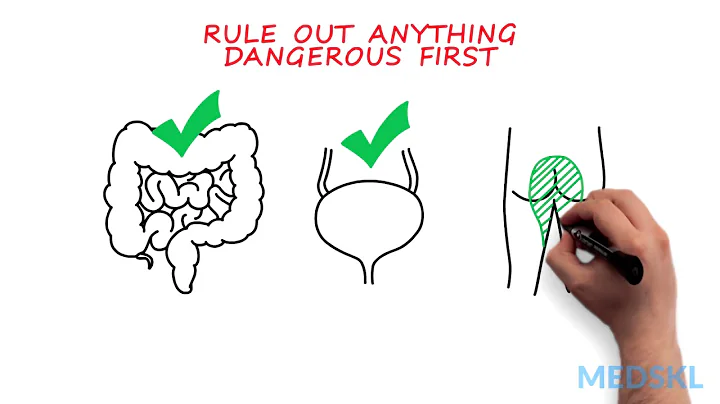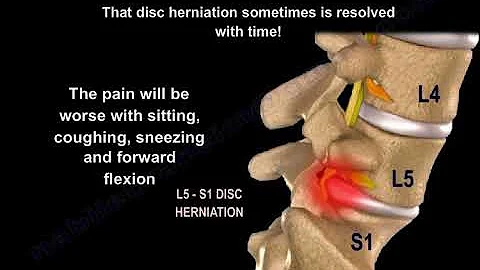Today I met a 60-year-old female patient with low back pain. told me when she entered the door: Lumbar disc herniation . She has had two surgeries. This time she has been ill for a few days and cannot walk. She asked me how to treat it. ?
My answer is very simple: is going to have the third surgery! Anyway, the surgeon has a way. Once the protruding part is taken care of, it will be over.
The patient hurriedly replied: I will never do surgery again! I'm afraid of the trouble...
Today, Dr. Kong will share with you guys, why this patient never chooses surgery again. Even if it hurts so much that he can't walk, he still chooses conservative treatment.
Case sharing
Symptoms: The patient suffered from low back pain accompanied by pain and soreness in the left lower limb, which made him unable to walk. What was particularly obvious was that it worsened as long as he sat.
Image: MRI of her waist showed: lumbar 4-5 intervertebral disc herniation to the left, lower edge of lumbar 4 vertebral body endlaminitis , and lumbar 3 vertebral body Schmer's nodules.
evaluation: In the special test examination, the straight leg raise was negative, the collapse test was negative, and there were no signs of nerve tension at all; its flexibility is very good, and the bilateral active straight leg raise can reach 85°; on the left hip 3. There is obvious tenderness next to the sacral vertebrae, as shown in the picture below at the crossed position:

During the process of bending over, the left and right circles as shown in the picture above are asymmetrical, mainly the right side moves upward, indicating that the pelvis is Skewed; then let him lie down and compare the length of the legs on both sides to see if they are the same length. The result is that the right leg is shorter than the left. After letting him sit up, the long leg on the right side becomes shorter than the left side, indicating that his ilium is misaligned after occurrence. When
was palpated with his bare hands, he found that the pelvis was asymmetrical between the left and right sides. The right side was significantly higher than the left side. There was obvious tenderness on the edge of the right iliac spine. The spine was curving to the right and lateral protruding to the left.

Analysis and consideration:
The patient’s pain is not caused by intervertebral disc herniation, because the nerve tone is not high and there are no corresponding signs and symptoms.
Although the MRI showed that the intervertebral disc between waist 4 and waist 5 had herniated to the left, it was due to abnormal stress due to long-term posture and posture abnormalities.

We can look at the picture above. When her lumbar spine bends to the right side, the stress on the intervertebral disc will be concentrated to the left, which means that the intervertebral disc on the protruding side will degenerate faster, or even bulge or herniate. This is her The underlying logic of disc herniation.
Talking about this, friends who read carefully should understand why I simply replied at the beginning of the article that the patient would undergo a third surgery. The doctor could indeed deal with the herniated disc, but could he deal with the root cause I analyzed? ? Am I teasing the patient to make her realize why she has recurring attacks?
treatment: During the entire treatment process, I did not touch her waist, but made manual adjustments around the pelvis, such as adjusting the dislocation and disorder of the sacroiliac joints, and targeting the structures on both sides that caused the pelvis and spine to deflect. After a few minutes of sexual relaxation and strengthening exercises, the patient said that there was not much pain when he got out of bed and walked. Especially the symptoms on the posterolateral side of the calf completely disappeared.

What does this case tell us about people with low back pain?
In our daily life, many people suffer from low back pain. To some extent, it is basically misdiagnosed as , low back and leg pain, and other symptoms are caused by lumbar disc herniation, and even surgery is performed... ......
In fact, there are many factors that can cause low back and leg pain, but we rarely go for physical examination, evaluation and analysis. Instead, we directly rely on films to make a diagnosis. This approach is wrong. Films show the structure of the interstitial disc. Is the protrusion causing the pain? If true, the effect of our conservative treatment will not be so miraculous.

Think about it again. In the case in the article, the previous two surgeries were due to disc herniation. Why did it protrude again this time? The analysis of the underlying logical relationship was not in place and it was not dealt with. I really need to prepare for the next one. 3 surgeries?
The purpose of conservative treatment is to treat the underlying cause and slow down the herniation of the interstitial disc. Do you think this is the truth?
Summary
Lumbar disc herniation is not the same as Lumbar disc herniation. For many problems of low back pain, conservative treatment is given after detailed analysis, evaluation and physical examination, and the effect is quite good.
I am Dr. Kong who takes you to learn about health science. I spend a lot of thought and energy on writing popular science every day. It is not easy to code. If you agree with what I say, please give me a like or a follow; sharing is a kind of Virtue, give roses to others and leave lingering fragrance in your hands! If you or your family or friends also suffer from such pain, please forward and share this article with those who need it, so that more people can benefit from it! Thanks!





















